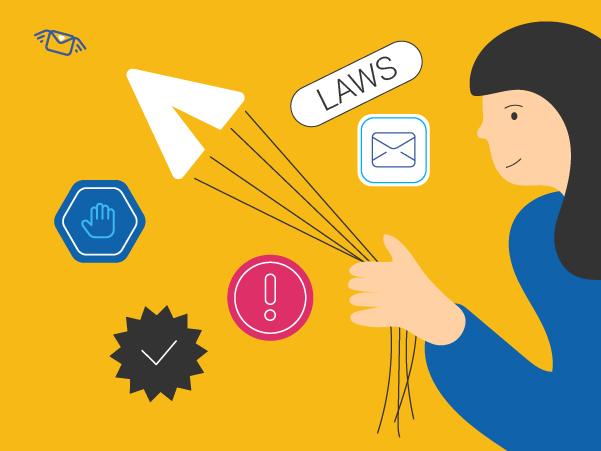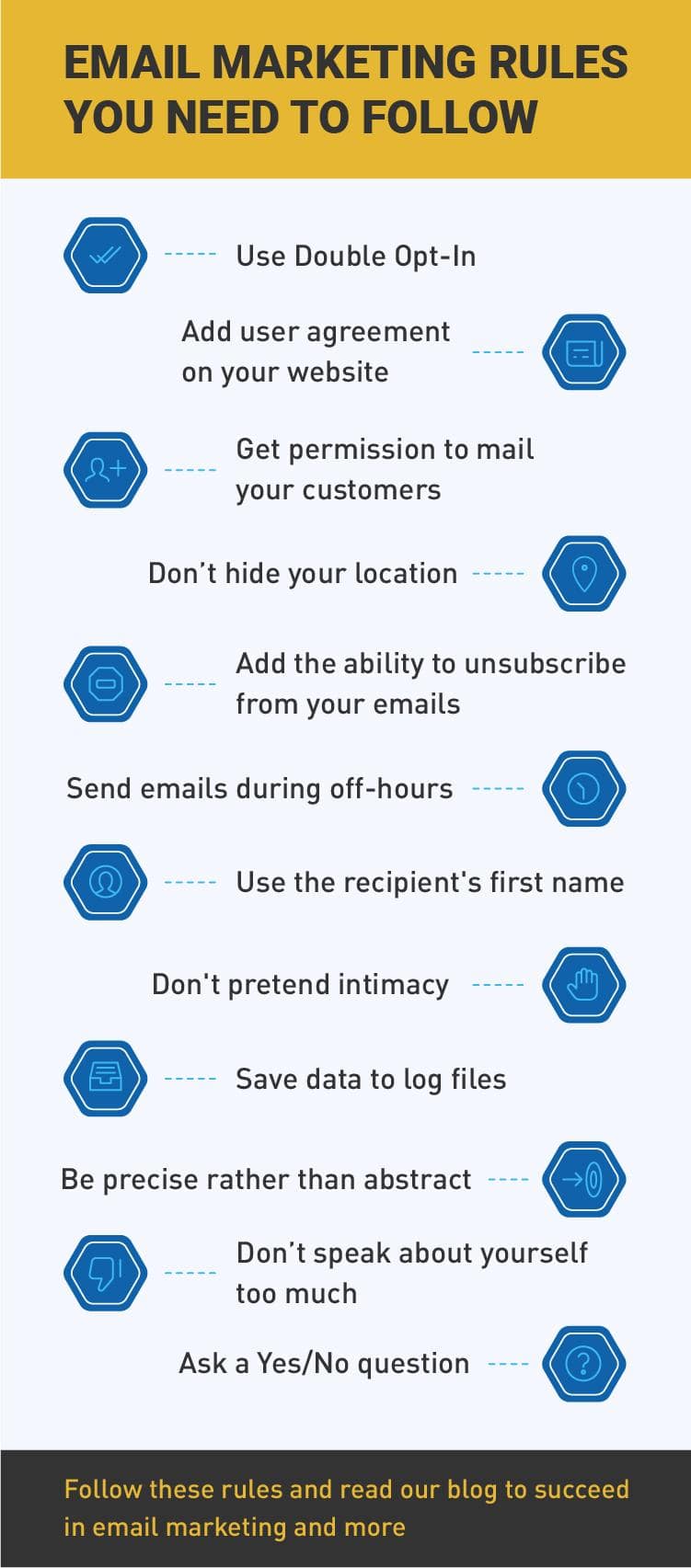

Mass mailing is a very important tool in your marketing strategy. With its help brands are able to communicate with customers and to convey your values. But whatever you do, you need to remember about main email marketing rules, such as compliance with the law spam and spam rules.
Read this article, and you will know what is canspam and how to create your strategy due to marketing regulations.
There is a number of laws governing email that guide the use of email marketing for commercial purposes. It’s the U.S. CAN-SPAM act, the CASL laws in Canada, and, in the UK, it’s a set of laws known as the Privacy and Electronic Communications Regulations of 2003.
All of these laws dictate a number of conditions that email marketers need to follow to avoid significant fines.
We all know that the can spam act influence badly on our reputation even if we are conscientious senders. But do we always follow canspam requirements in order not to become a spammer? Someone does, but we are sure that all of us need a special checklist that will protect from fines and problems with the law.
We prepare the most important tips you should follow not to face problems with law.

Double Opt-in is a type of subscription in which the user not only leaves an email, but also confirms its validity from the letter.
How it happens: John found an interesting travel blog. In order not to miss the news, he decided to subscribe to the email newsletter. He left his name, email address and, according to tradition, Double Opt-in received an email with a link to confirm the validity of the email address.
That's it, now his data is in the company's database, and happy John will receive useful things from the world of travel every week.
Pro tip: if you use email hunting tool send the first email with unsubscribing link. In such case people who are interested in contribution becomes in your base, and those who don’t want to receive your emails just unsubscribe.
This is a document that include the mass email regulations between you and your customers. Important: place it in a prominent place, so anyone can read it.
For internet marketers, the following points are priority:
The distribution of advertising messages. Write what kind of emails you send, what benefits clients get.
Terms of subscription and unsubscription. Show us how to unsubscribe from the mailing list. Demonstrate all the ways and show that it is easy to do.
Each subscriber from your base must agree to receive emails from you. If you don’t follow this rule, the user has a right to report Spam.
Add a line with a simple sentence: “I agree to receive email newsletters” and be calm.
Email marketers have a trick to leave this checkbox filled. This trick is not a violation of the law, but may trigger an investigation by the recipient’s country law. So it's better to give the user the ability to click on their own.
Place your contact information in every email: company name, website address, contact phone number and physical address (if you have it). This will increase the user's level of trust.
After all, receiving letters from mysterious senders is not very interesting. Protection from ads and spam is important for users. So be one of their heroes. Submit only pre-agreed content.
Also indicate at the beginning or at the end of the letter where you got the user's email from. Feel free to mention this at the end of every email.
Each of your letters must contain a link for unsubscribing. Mutual respect on the internet is as important as in real life. Respect the person's right not to receive emails from you. In addition, thanks to such honest replies, you will protect yourself from complaints about spam and problems with mail providers. Follow the unsubscribe law and be polite with your customers. Сanned spam act is drawn by its terms not to "spam," but to "multiple commercial electronic mail messages" (with "multiple" being defined in specific numeric terms of messages sent per day, week, or month), a category that would presumably include, but not necessarily be limited to, UCE/spam.
Each user should understand how not to receive mailing lists.
Three rules for a good unsubscribe link:
It is noticeable. Don't hide it at the end of your email with a tiny, faded font.
The text of the link makes it clear: if you click it, the user will unsubscribe from the mailing list.
Unsubscribing is fast. 1-2 clicks, and you're done. Don't force users to browse your website in order to find information on how to stop receiving any more emails from you.
The simpler and more friendly the unsubscribing process, the more chance you have that an audience can return to you later.
Unsubscribe from emails law is mandatory.
A lot of research has shown that bulk emails are much more likely to get a response if the mailing time is not in the middle of the working day. And later, when employees are less busy and have time to read your emails.
All nice to receive a personalized letter, when called by name. And not common, "Mr. / Mrs."
Call the recipient by name, this is very attractive and increases audience loyalty.
Remember that you send emails not to your friends, but to your customers, so don’t try to be “too friendly” and don’t write familiarly. It’s okay to ask your customers if they like your articles and products. But such emails like “Hoping you have a great winter holiday” or “We wish you and your family to be healthy and wealthy” sound weird when they are received from strangers. Digital privacy is very important.
Logs is a history of user actions on the site. Why should you keep it?
If supervisory authorities come to you, the log files will be proof that the user really subscribed to your emails and left his email address.
Log files are stored in the hosting control panel. They can also be saved in the computer's memory. It will definitely not be superfluous!
Do not use stamps and template phrases. Sharing stories of "nothing" is not useful for readers. Write about real cases, give examples that reveal the essence.
Writing constantly about how good, honest, and generally the best you are can be a red flag for your audience. They may question your honesty.
Write more about them. Remember that your goal is to cover and help clients' pains, not to praise yourself with or without reason.
The easiest way to start communicating with subscribers is to ask a simple question to which they can answer yes or no. For example: "Is the article useful to you?" or "Will you apply the advice from the checklist in your future work?"
Follow our simple tips, and you will never receive a mailing penalty or audience resentment.
Email blasting can spam violations, but here we have a memo for you. Before you begin sending campaigns for your business, it’s important to understand the laws around email marketing and how to comply with them. Every marketer should be aware of can spam violations:
The General Data Protection Regulation (EU) 2016/679 (GDPR) is a regulation in EU email protection law on data protection and privacy in the European Union (EU) and the European Economic Area (EEA). It also addresses the transfer of personal data outside the EU and EEA areas. The GDPR's primary aim is to give individuals control over their personal data and to simplify the regulatory environment for international business by unifying the regulation within the EU. Superseding the Data Protection Directive 95/46/EC, the regulation contains provisions and unsubscribe requirements related to the processing of personal data of individuals (formally called data subjects in the GDPR) who are located in the EEA, and applies to any enterprise—regardless of its location and the data subjects' citizenship or residence—that is processing the personal information of individuals inside the EEA.
SPAM AFTER CAN-SPAM provision:
The rapid growth in the volume of UCE threatened the convenience and efficiency of e-mail;
UCEs accounted for more than half of all e-mail traffic;
Most UCEs were fraudulent or deceptive;
UCE resulted in costs to recipients of UCE, including the costs of storage and costs associated with the time spent accessing, reviewing, and discarding the mail;"
UCE was costly to ISPs, businesses, and educational institutions because of the need to increase storage or bandwidth or both;
The receipt of a large volume of UCE increased the chances that wanted email would be discarded or ignored;
Many states had enacted mutually-inconsistent versions of anti-spam legislation that had not alleviated the spam problem and were difficult to enforce.
Here are some simple tips and rules for emailing to help you deserve subscribers’ loyalty and avoid fines:
Send messages only to those customers who have given written consent to the newsletter.
Allow recipients to unsubscribe from the newsletter. Information may become irrelevant for them. Make it easy to unsubscribe.
Provide only important and valuable information. Don't get bored with daily “hot deals” and “nothing” news.
If you aren’t sure if your subscribers want to stay subscribed, ask. Email marketing and the law must be inseparable.
You can also send SMS with a substitution of the number. If you register with the service, messages to clients can be sent from another number. Such a service becomes necessary if you have applied for a name registration, but it has not yet been approved by the operators. In order not to violate the regulations, write the name of the company in the body of the SMS. Then your customers will understand who is writing to them.
Use the tips in this article and follow our blog for the latest updates.
And remember: email marketing laws and regulations must be followed.
Use tracking email software to get sure that you do everything right.
Monitor your campaigns with Atomic Email Tracking System and don’t worry about your bulk emails.



Subscribe to us and you will know about our latest updates and events as just they will be presented





